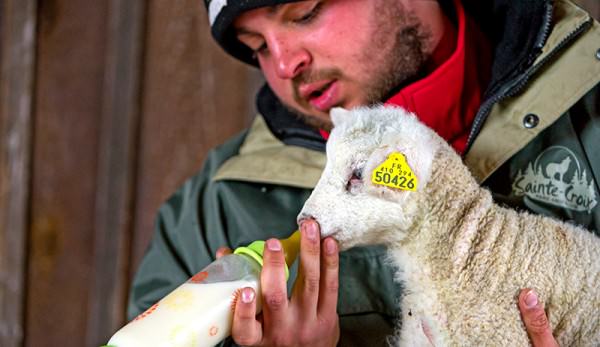
It’s a settled fact that mother’s milk is the best starting food for baby animals: species-specific, perfectly balanced in nutrients, sterile and already paid for. However, there are occasions when that perfect source is not available. Maybe it’s because you and your family want the milk, too, or maybe a ewe can’t care for all her lambs, the piglets just aren’t thriving, or you’ve got an orphan on your hands. If any of these fit your picture and your baby animal is not yet weaned, then you’re going to need to use milk replacer.
Custom Nutrition
Milk replacer is exactly what its name implies: replacement for mother’s milk for baby animals. Each species does best on replacer that mimics the nutrient balance in its mother’s milk as closely as possible. Sheep’s milk is higher in protein and lower in lactose than cow’s milk, for example, so just because your dairy cow is giving a lot of milk and you could save money feeding that excess to your bottle lambs, resist the temptation.
Not all milk replacers are the same, noted Dr. Hugh Chester-Jones, animal scientist at the Southern Research and Outreach Center in Waseca, Minn., and Neil Broadwater, extension dairy educator at the University of Minnesota, in their 2009 MN Dairy Days presentation, Milk Replacers.
“There are many different milk replacers on the market that vary in protein and fat content and which come from different sources,” they state. “Read and understand the feed tag so you know if a particular replacer is appropriate for your feeding program and growth goals.”
Pointers On Protein

When choosing a milk replacer, look at the protein levels and the source. Milk-sourced protein is most easily absorbed but more expensive than vegetable-based or animal-based protein. Cheaper milk replacers may compromise your animal’s growth and well-being. In regard to cattle milk replacers, authors Coleen Jones and Jud Heinrichs at the Penn State Extension wrote in “Milk Replacer Costs and Your Options:”
“Nonmilk proteins are not acceptable for feeding calves less than 3 weeks of age. These calves do not digest nonmilk proteins efficiently.”
Medicated Milk
Some milk replacers contain prophylactic antibiotics, which means that a low dose of medicine is included in the replacer as a sort of “insurance” that the baby animal doesn’t come down with bacterial infections. This sounds like a smart idea, but in reality, this practice is not indicated in most situations. Besides the fact that medicated milk replacers are more expensive, a closer look shows they aren’t necessary. The Washington State University Extension says:
“There are an increasing number of studies that show no benefit to feeding calves antibiotics. Calves fed antibiotics have very resistant gut bacteria, there is little evidence that the antibiotics have value in preventing diarrhea, and calves that have received adequate colostrum and fed antibiotics are more likely to have diarrhea than similar calves not fed antibiotics.”
Ultimately, they recommend treating illness with medicines specific to the condition only in the animals that exhibit symptoms. Furthermore, just as we have discovered with humans, overuse of antibiotics can lead to drug-resistant germs.
Check the labels to see what, if any, medicines have been added to ward off scours and such. Especially for smaller operations that can monitor individual animals for health and treat only those that need it, there isn’t as much need for medicated milk replacer. Be aware that the USDA has regulations for medication withdrawal periods in order that the meat is medication-free.
Transitioning To A Milk Replacer
It’s not difficult to transition to a milk replacer, especially for animals that take to a bottle or bucket readily. If you have the opportunity to transition from mother to milk replacer gradually, this will be optimum for your baby animals, because their digestive systems need to adjust to the change in nutrients.
It may also take them a bit to take to the new taste. One way to ease them into this is to mix mother’s milk with milk replacer, gradually increasing the replacer and phasing out the mother’s milk. One recommendation is to mix 75 percent existing milk source to 25 percent new on the first day or two, then 50/50, and lastly 75 to 25 percent before transitioning to 100 percent milk replacer. If you don’t have that leisure—an orphan or perhaps a day-old calf or lamb from a nearby farmer—transition from colostrum to milk replacer in a similar fashion. Use this gradual method if you switch from one kind of milk replacer to another as well.
By choosing a milk replacer containing good-quality protein and species-specific formulation as well as transitioning incrementally, your bottle baby will continue to thrive just like its mother-raised counterparts.




